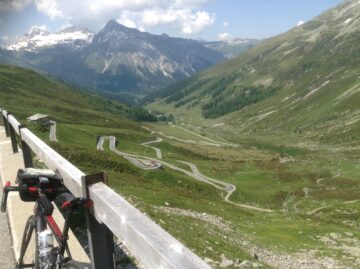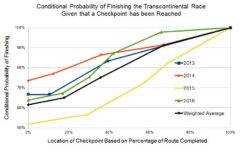This page contains information about the 2023 Transcontinental Race No9. See the Overview page for a general introduction to the Transcontinental Race (TCR). See also the official TCR website.
Page Contents:
Organization

Lost Dot is the company that was formed in 2018 to run the Transcontinental Race after the race’s founder Mike Hall was killed while racing his bike in Australia. Anna Haslock, who had been Mike’s partner, was Lost Dot’s Managing Director since it was formed and the TCR’s Race Director. Anna announced in 2021 that she was gradually stepping away from these roles and starting with the 2023 race, she will no longer be the Race Director. The new team of David Ayre and Andrew Phillips will be assuming her roles, see this page for more details. Despite changes in personnel, it’s expected that the race’s format, organization and goals will not change significantly.
The application process for TCR No. 9 was similar to recent years. The route was announced in late November 2022 and applications were open for a couple of weeks in December. The application had a non-refundable cost of 25 UKP and included a screening process to ensure that applicants understood the principles of the race and what the challenge would involve.
Those who answered the screening questions satisfactorily could be automatically given a starting spot if they (a) fit certain demographic characteristics to ensure some gender, ethnicity and nationality diversity, (b) had helped in a recent Lost Dot event as a volunteer, or (c) had an established record in ultra-distance cycling showing that they were capable of competing for the win.
The other applicants who passed the screening stage were entered into a random lottery. A total of 300 spaces were available and about 900 applications were received. Applicants were informed at the end of January 2023 whether they had been successful. Successful applicants then had to pay the 440 UKP registration fee in two installments.
In early February there was a separate opportunity to apply for a place in the race through the Mike Hall Bursary program. The bursary was introduced for the 2022 race “to support riders from lower income households” and to improve “diversity, equality and inclusion within cycling”, more details at Lost Dot. The application fees of non-successful applicants supports he bursary fund.
Route Summary

The race will again use the classic start location in Geraardsbergen, Belgium, starting with a climb up the short, steep, cobbled Kappelmuur climb. Riders will then head south-east towards Switzerland, probably crossing the Vosges mountains and up some of the Rhine valley.
The obligatory parcours for the first checkpoint starts on the other side of the Alps, in the Italian-speaking part of Switzerland, Ticino. It will be surprising if any riders use an alternative to the most obvious route, the Gotthard pass.
Having just crossed the spine of the Alps once, riders must do so twice more in quick succession with the San Bernardion Pass and the Splugen Pass (or Passo dello Spluga), where they will enter Italy. The parcours is over at the bottom of that pass, near the northern end of Lake Como, but the control point that must be visited is in Livigno, so riders are likely to go back into Switzerland briefly, through St Moritz and over the Bernina Pass.
CP2 is also in the Alps, in northern Slovenia and directly east of Livigno. There are lots of mountains and valleys in between, so riders will have to choose their route strategically to make it efficient and not too long. The parcours for CP2 includes a small gravel road high in the Slovenian Alps.
Many riders have passed through Albania in previous TCRs on their way to the finish in Greece or Turkey, but there has never been a control point there. The obligatory parcours is over an old trade route in the mountains west of Peshkopi. The images show that the road is more of a reasonably rough gravel track.
In 2017 and 2018, the race finished at the Meteora monasteries near Kalabaka, Greece. This time that will be the fourth control point. Before getting there, 2 other sections of obligatory parcours must be ridden in the mountains west of Kalabaka. The first section is up to the village of Melissourgi, the second section is down from the town of Theodoriana. Between the two is a high ridge with a small path/track going over it. Riders will have the choice of finding out how much of that is rideable or staying on the roads and going the long way around the mountain.
Some riders have criticized the organizers in the past when they’ve included unrideable mountain tracks in the obligatory parcours. It appears that this is the organizers response – make the tricky section optional, but with the alternative being much longer.
There are yet more mountains and valleys to navigate between the end of the 2nd section of the CP4 parcours to get to Kalabaka where the 3rd section of CP4 parcours starts, and then climbs up past the monasteries that are perched on rock towers. The mountainous terrain continues after that as riders need to head north-east to the finish in Thessaloniki.
Heading straight for Thessaloniki would be too easy, so riders must first go 100 km north to ride along Lake Kerkini, which is an excellent birdwatching area, especially at certain times of year. We’ll see whether any riders will have time for some wildlife photography.
The riders will then ride into Thessaloniki for the finish. Thessaloniki was announced as the finish location for the 2021 Transcontinental Race, which was cancelled due to the ongoing Covid pandemic.
Logistics & Distance
The race will start at 22:00 on Sunday, July 23rd, 2023. Riders will need to finish in under 17 days to be awarded a place in the General Classification.
The distance ridden is expected to be the shortest since 2014 at around 3,600 km. However, the total climbing is likely to be one of the highest at around 45,000 m. This gives a rate of climbing of 1,250 m of climbing and descent per 100 km ridden, which would be the highest of any edition yet – in other editions this has generally been below 1,000 m per 100 km.
The other difficult aspect of the route is that a lot of the climbing will be in the final 1000 km, in the Albanian and Greek mountains, when riders will already be very fatigued. Hopefully riders will plan for this by equipping their bikes with appropriate Gear Ratios gear ratios and also try to save some physical and mental energy for the final third of the race and schedule accordingly because progress is likely to be slow in that phase. In most previous editions of the TCR, there were not any major obstacles in the final several hundred kms of the race.
Last significant page update: February, 2023
This page is in the The Transcontinental Race section. The next page in this section is:

